XNUMXD printing in the military
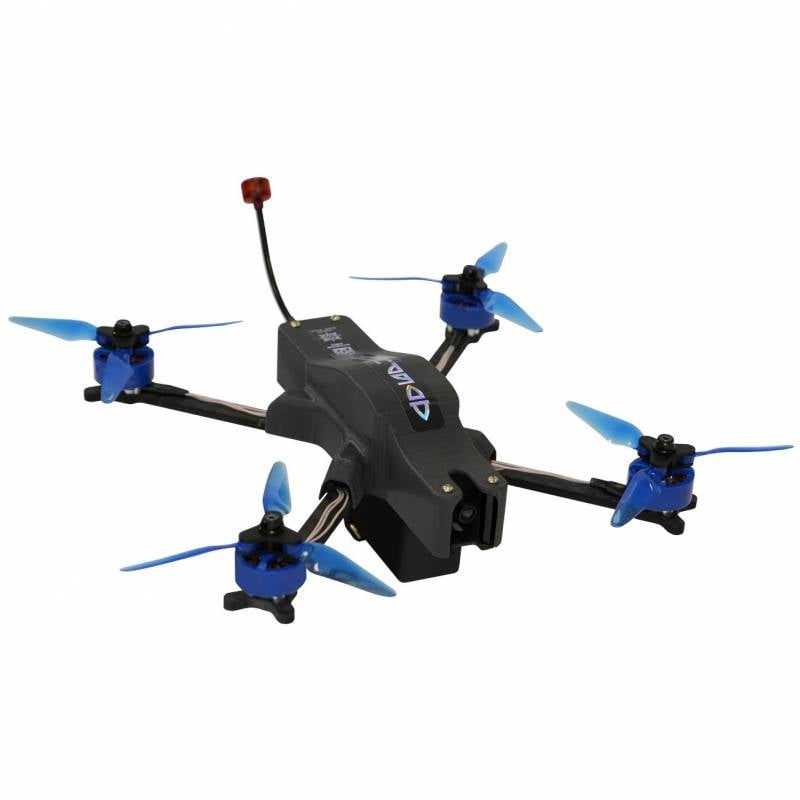
Light UAV "Dobrynya" with a printed body. Photo "Obukhov plant" / Concern VKO "Almaz-Antey"
In recent years, there has been an active development of 3D printing technologies. A variety of XNUMXD printers with various capabilities and features are being developed, new materials are being introduced, etc. New technologies and devices are used in various fields, incl. in military affairs. Printed parts can be used in production, repair and even construction - all these possibilities have already been tested in practice.
Subject of interest
10D printing or additive manufacturing is a fairly old invention - the first experiments in this area date back to the eighties. The active development of the direction began 15-3 years ago, thanks to the appearance of some necessary components and technologies. To date, a number of different printing technologies have been developed or improved, a lot of XNUMXD printers of various classes and purposes have been created, etc.
The military of the leading countries of the world began to show interest in additive processes at the turn of the XNUMXs and XNUMXs, when their potential became clear. The first studies and experiments began in the specialized structures of the ministries of defense and at enterprises of the military-industrial complex. Both the possibility of manufacturing certain parts and ways to put these technologies into practice were studied.
To date, the defense industry and the armies of the leading countries have sufficiently studied and mastered a new range of technologies. In a number of countries, 3D printers and related systems are already being used in production and complement "traditional" tools and methods. At the same time, in some areas of production, printed parts have not only become familiar, but also crowd out other products.
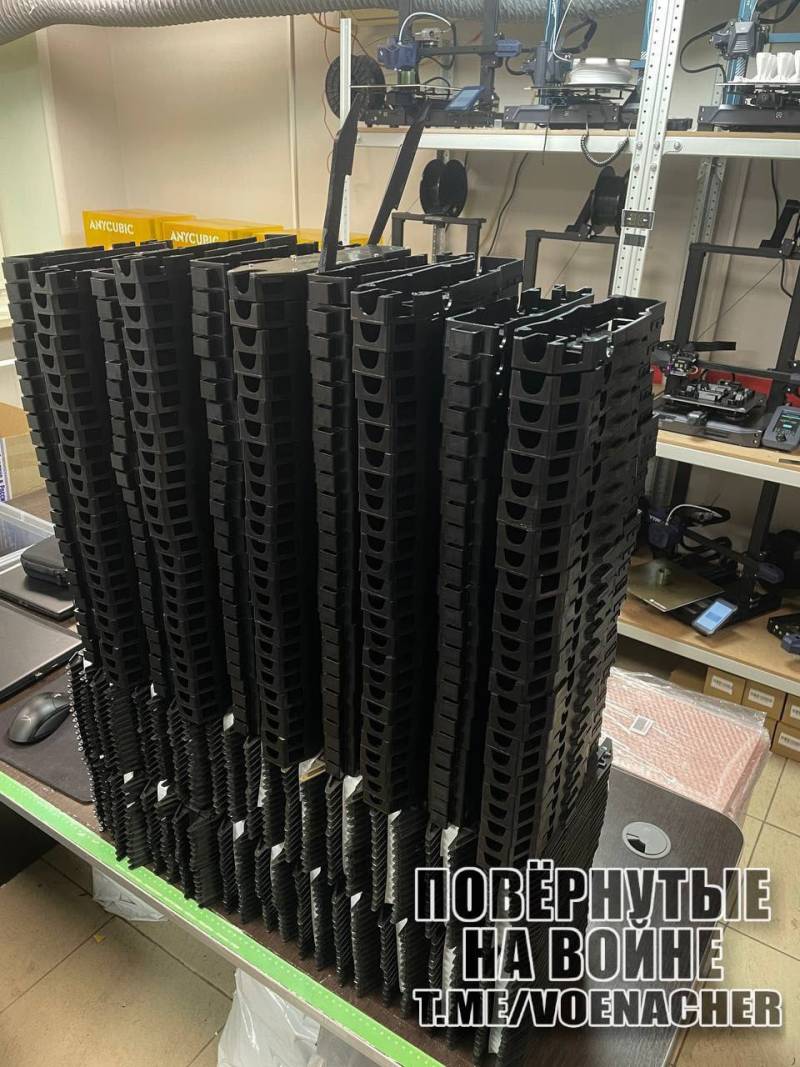
Mass production of hulls for the "Ghoul" UAV in a small workshop. In the background are printers. Photo Telegram / "Turned in the war"
However, additive technologies do not yet claim a leading position in the industry. For all their potential and current hype, they have certain limitations. Given these factors, it is possible to combine different technologies and optimize the production process of various products. At the moment, it is this introduction of 3D printing, taking into account the needs and capabilities of the industry, that is of the greatest interest.
Manufacturing technology
Three-dimensional printing, regardless of the specific technology and material used, can be used for the relatively simple manufacture of parts of complex shape and configuration. In fact, it is possible to get rid of various restrictions imposed by "traditional" machines and tools. The defense industry and the armies have long appreciated these opportunities and began to use them.
First of all, experiments were carried out with the manufacture of "body kit" and other accessories for small arms. weapons and fighter equipment. The resulting products are more convenient in terms of production and can have almost any shape. At the same time, developers need to take into account the characteristics of the material used and the characteristics of the operation of the finished product - in order to avoid defects and breakdowns that are not typical for "ordinary" products.
It is curious that additive technologies have developed in parallel with the unmanned aviation, and the two directions intersect. Printing is a fairly popular technology for manufacturing the main parts of light and medium UAVs. For example, now in our country several small drones with frames and cases made on 3D printers.
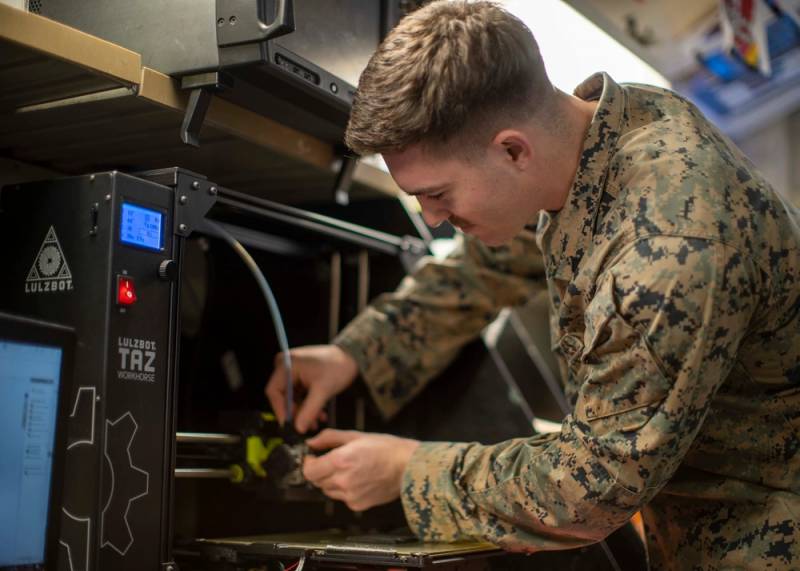
3D printer on board the American UDC USs Essex, 2022. Photo by the US Department of Defense
In the field of unmanned aircraft, printing has found another application. Printed parts are used to make transport and drop systems for UAV ammunition. In addition, shanks, stabilizers, etc. are coming out of printers en masse. parts for turning serial grenades or mines into aerial bombs. Without additive technologies, the production of such "aircraft weapons" would be difficult.
The possibility of increasing the size of the printed part is being studied. In addition, new materials are being studied. For example, in the United States, the idea of XNUMXD printing of large-sized armored steel panels has been proposed. This technology will reduce the number of joints and welds in the armored hull, which will improve its resistance to damaging elements and shock waves.
In the field of repair
Obviously, printed parts can be used not only in the manufacture of various tools and samples, but also in their repair - incl. to replace elements of "normal" origin. However, in this case, the correct selection of material and technology for manufacturing is necessary.
Experiments of this kind have been carried out by the US Navy for several years. Thus, in 2014, the USS Essex (LHD-2) amphibious assault ship received new equipment from the ship's workshop as part of a scheduled overhaul and modernization. In particular, a 3D printer for the manufacture of plastic products appeared in it. With its help, it was proposed to independently make various parts and spare parts - covers, containers, etc., up to scale models of equipment for tactical events.
Later, a similar experiment was carried out on board the multi-purpose submarine USS New Hampshire (SSN-778). A printer for working with plastic also appeared on board, but a later model with different characteristics.
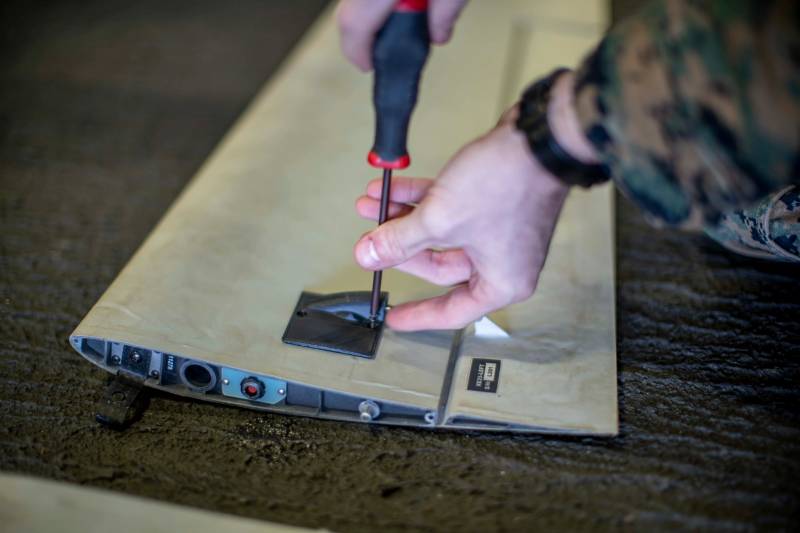
Installation of the finished printed part on the UAV. Photo by the US Department of Defense
The plastic printers performed well and provided minor repairs and replacements for damaged/lost parts. The new technology has received high praise. At the same time, experiments with metal printing have been postponed to an indefinite future due to the high complexity.
However, such experiments began in 2022. Essex again became the platform for them. On board, the development and printing of parts was practiced at the pier and on the high seas. Working with metal required more energy, but in general the experiment was recognized as a success.
The issues of additive manufacturing of parts for the repair of various equipment are also being worked out by other structures of the US armed forces. Thus, the army is actively experimenting with the repair of ground equipment. The Air Force and the ILC have already tested the possibility of minor repairs of aircraft, although so far we are talking only about individual parts that are not under load.
Apparently, the US Army will continue to experiment with three-dimensional printing, and then begin to implement the experience gained in practice. Such technologies make it possible to relatively quickly and easily repair equipment and machinery, and also reduce dependence on supplies. The possibility of independent production of the necessary products will be of particular interest the fleet and repairmen from remote garrisons.
Military construction
Three-dimensional printing can be used in construction, and various complexes of this kind are being developed. The ability to print entire buildings predictably interests the military. So, since 2015, the US Army Corps of Engineers, a number of Pentagon specialized organizations and related enterprises have been studying the issues of large-size printing and developing appropriate systems.
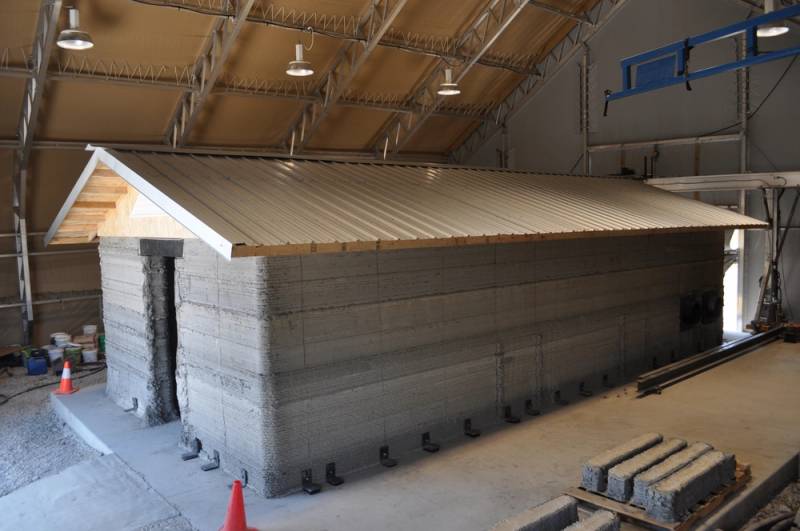
A concrete structure printed by a special printer. Photo by the US Department of Defense
To date, several models of construction 3D printers using concrete mortar have been developed and brought to testing. Various barriers, small shelters and larger structures are successfully printed. The maximum building area is close to 50 sq.m and is limited mainly by the technical features of the printer used.
The potential of construction printers is expected to grow. The areas of printed structures and buildings will increase, it is possible to introduce new materials, etc. Regardless of the path of further development, the general advantages of this method of construction are already clear. A construction printer allows you to reduce labor costs and to some extent speed up the construction of the necessary buildings.
Combination of technologies
The additive manufacturing process has long shown its capabilities and ability to solve a wide range of problems. Technologies of this kind and related equipment are being actively introduced in various fields, and their further development allows us to make optimistic forecasts for the future.
3D printers predictably became of interest to the defense industry and the military, and then found their place in the military. They are already used in the manufacture and repair of various products, and various studies are being carried out with an eye to the future. Obviously, the military and industry will no longer abandon a convenient and promising way to manufacture parts, and will continue to develop it, and along with other production technologies. And the introduction of new technologies can again affect the appearance and capabilities of future products.
Information